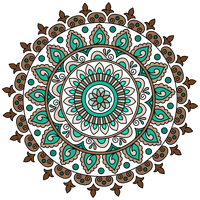Understanding Chakras: The Sacred Geometry of Energy and Balance
How Chakras Shape Your Energy Flow and Spiritual Well-Being
 Chakras, those mesmerizing designs that captivate the soul with their vibrant colors and intricate shapes—are much more than mere symbols. Each chakra is a gateway to understanding our inner world and connecting with the cosmic energies surrounding us. These sacred symbols, or mandalas, embody profound spiritual concepts rooted in ancient traditions, representing the journey of self-awareness, healing, and spiritual growth. Chakras and their meanings are more significant in our lives than we give importance to them.
Chakras, those mesmerizing designs that captivate the soul with their vibrant colors and intricate shapes—are much more than mere symbols. Each chakra is a gateway to understanding our inner world and connecting with the cosmic energies surrounding us. These sacred symbols, or mandalas, embody profound spiritual concepts rooted in ancient traditions, representing the journey of self-awareness, healing, and spiritual growth. Chakras and their meanings are more significant in our lives than we give importance to them.Chakras Explained
Chakra symbols, like the piece you see here, are more than just beautiful patterns—they are a spiritual map, guiding us towards harmony and balance within ourselves and the universe. As an artist specializing in dot art mandalas, I strive to capture these deep meanings and present them in a way that resonates with our innermost beings.
Chakra colors in body starting from the root chakra and going up: red, orange, yellow, green, blue, indigo, purple.
The Seven Chakras in Order and Their Meanings
1. Root Chakra (Muladhara)
 The Root Chakra, or Muladhara, is located at the base of the spine and represents our foundation and grounding. It is associated with the earth element, symbolizing stability, security, and the basic needs of life. The root chakra’s symbol is a four-petaled lotus with a square and an inverted triangle, representing earth's grounded energy and our connection to the physical realm.
The Root Chakra, or Muladhara, is located at the base of the spine and represents our foundation and grounding. It is associated with the earth element, symbolizing stability, security, and the basic needs of life. The root chakra’s symbol is a four-petaled lotus with a square and an inverted triangle, representing earth's grounded energy and our connection to the physical realm.2. Sacral Chakra (Svadhisthana)

The Sacral Chakra, or Svadhisthana, is located just below the navel and embodies creativity, fluidity, and emotional expression. It is associated with the water element, symbolizing the constant flow of emotions and desires. The six-petaled lotus of the sacral chakra reminds us of the importance of overcoming negative emotions to experience joy and creative freedom.
Balance your Sacral Chakra by engaging in creative activities, dancing, or connecting with water.
3. Solar Plexus Chakra (Manipura)

The Solar Plexus Chakra, or Manipura, positioned around the navel, is the seat of personal power, confidence, and self-discipline. The ten-petaled lotus and the inverted triangle symbolize fire and transformation. This chakra drives us to achieve our goals and represents the "fire in our belly" that fuels our determination and willpower.
Balance your Solar Plexus Chakra by practicing self-care, setting healthy boundaries, and working on self-empowerment.
4. Heart Chakra (Anahata)

The Heart Chakra, or Anahata, located in the center of the chest, connects the lower and upper chakras and represents love, compassion, and unity. Its twelve-petaled lotus and interlocking triangles (forming a hexagram) symbolize balance, harmony, and the union of male and female energies.
Balance your Heart Chakra by practicing compassion, forgiveness, and loving-kindness meditation.
5. Throat Chakra (Vishuddha)

The Throat Chakra, or Vishuddha, is associated with communication, self-expression, and truth. Located at the throat, its sixteen-petaled lotus symbolizes the purity and clarity of expression. The inverted triangle within a circle represents the pathway to our higher self and our ability to speak our truth.
Balance your Throat Chakra by singing, chanting, or practicing honest communication.
6. Third Eye Chakra (Ajna)

The Third Eye Chakra, or Ajna, located between the eyebrows, is the center of intuition, insight, and spiritual awareness. The two-petaled lotus represents the duality of the Self and the Divine. This chakra helps us see beyond the physical world and perceive the true nature of reality.
Balance your Third Eye Chakra by meditating, journaling, and trusting your inner wisdom.
7. Crown Chakra (Sahasrara)

The Crown Chakra, or Sahasrara, situated at the top of the head, represents spiritual enlightenment, self-realization, and divine connection. Its thousand-petaled lotus signifies the infinite connection to the universe and the divine. This chakra is the gateway to pure consciousness and spiritual awakening.
Balance your Crown Chakra by meditating, practicing gratitude, and connecting with the divine.
Bringing Chakras to Life Through Art
As an artist, my aim is to breathe life into these sacred symbols through my dot art mandalas. The piece featured above is available on www.dotartmandalas.com It captures the essence of all seven chakras in their vibrant forms. Each dot and pattern is placed with intention and infused with positive energy to inspire balance and harmony in your space.
Embrace the power of chakras and allow these beautiful symbols to guide you towards a balanced and harmonious life. Remember, the universe is within you - align yourself with its energy, and let your inner light shine.
Celestial Chakra Harmony Wall Decor
This artwork is an authentic and original piece. It is truly unique, and there is no other like it, nor will there ever be. It is crafted with precision, care, and a deep connection to nature and spirituality, making it a one-of-a-kind creation.
If it is still available, you can get it here.
The creation process is documented on Instagram @dot.artmandalas



